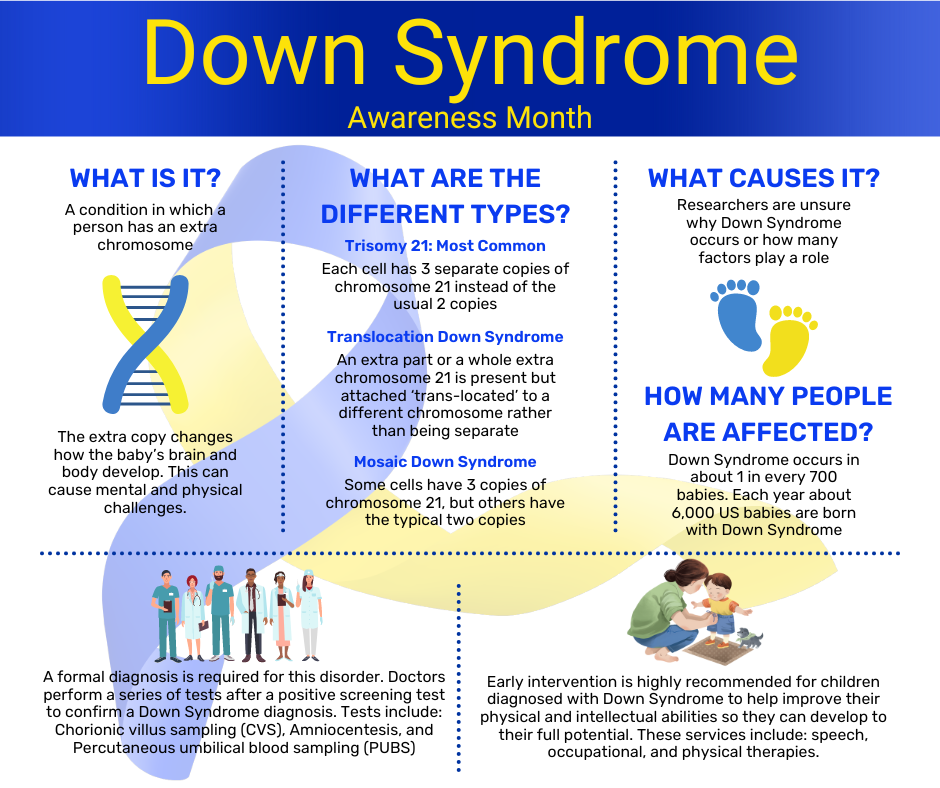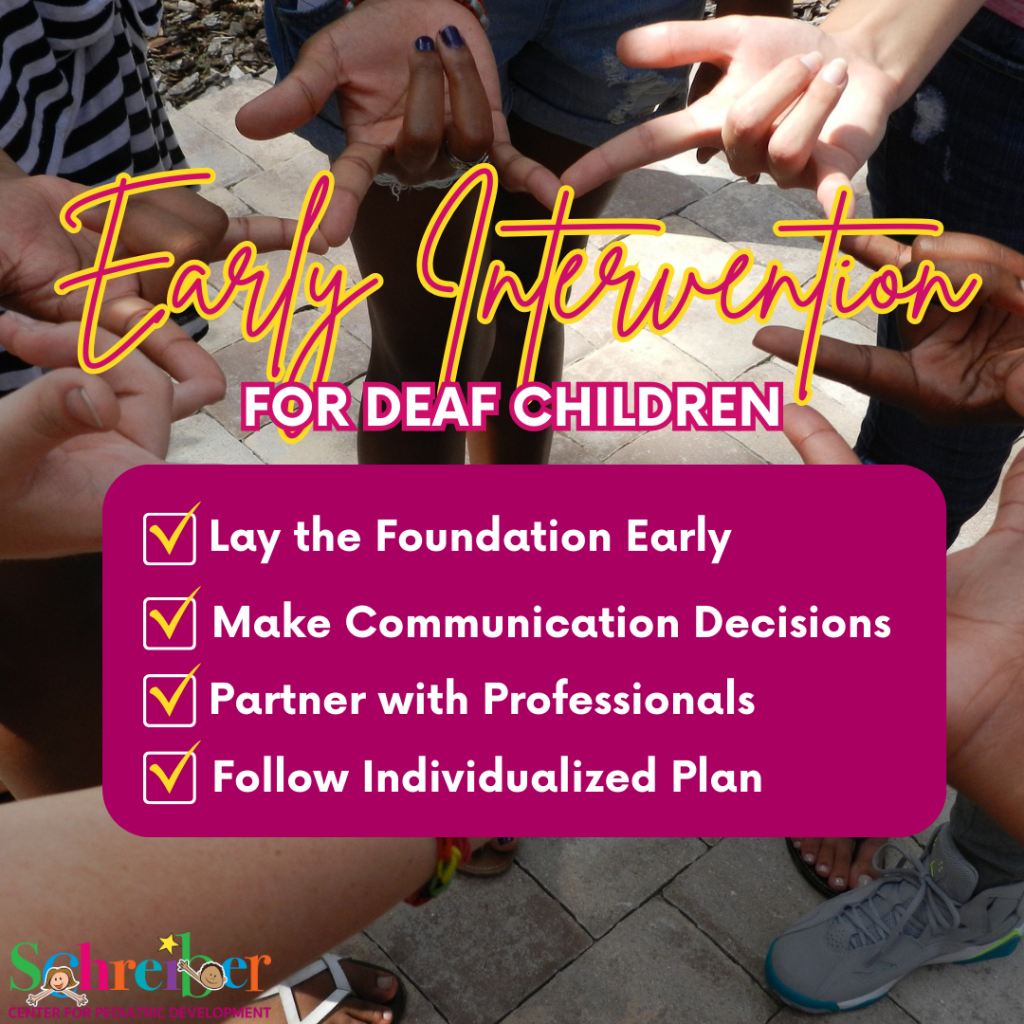Tag: early intervention
Down Syndrome Awareness Month
October 16, 2023This month we have the opportunity to raise public awareness about the condition Down Syndrome, as we advocate for the inclusion and acceptance of people with Down Syndrome. It is an unfortunate fact that people with Down Syndrome continue to face stereotypes and misconceptions about their abilities. We urge you to take this month to learn more about this condition and help us to spread the message of acceptance and respect for all people with Down Syndrome all year round.
What is Down Syndrome?
Down Syndrome is a genetic condition that occurs when a person is born with an extra chromosome. People are typically born with 46 chromosomes, but a person with Down Syndrome has an extra copy or part of an extra copy or chromosome 21.
There are three different types of Down Syndrome, and they are all dependent on how the extra chromosome 21 presents within the diagnosed person.
The most common type of Down Syndrome is called Trisomy 21, and about 95% of people who are diagnosed with Down Syndrome are diagnosed with this type. Trisomy 21 means that each cell within the body has three copies of chromosome 21 instead of the usual two copies.
The second most common type of Down Syndrome is called Translocation Down Syndrome and only about 3% of people diagnosed with Down Syndrome have this type. Translocation Down Syndrome occurs when an extra part or a whole extra chromosome 21 is present but attached ‘trans-located’ to a different chromosome, rather than being separate as is the case of Trisomy 21.
The least common type of Down Syndrome is called Mosaic Down Syndrome and only 2% of people who are diagnosed with Down Syndrome have this type. Mosaic Down Syndrome means that some of the cells in the body have three copies of chromosome 21, but other cells in the body still only have the typical two copies. Because only some of the cells in the body contain this additional chromosome this type of Down Syndrome presents less dominantly in physical features than the other two.
How do I know if my child has Down Syndrome?
About 6,000 babies are born with Down Syndrome in the US every year: that’s about 1 in every 700 babies. Down Syndrome can be detected in utero with screening tests and/or diagnostic tests. Screening tests can tell you if your pregnancy has a higher or lower chance of resulting in a baby with Down Syndrome, but they do not provide an absolute diagnosis. Diagnostic tests on the other hand, can typically detect whether a baby will have Down Syndrome. Diagnostic tests can be risky and are not generally performed until after a positive screening test. They include Chorionic villus sampling (CVS) which examines the material from the placenta, Amniocentesis which examines the amniotic fluid, and Percutaneous umbilical blood sampling (PUBS) which examines the blood from the umbilical cord. Each of these tests look for changes in the chromosomes that would indicate a Down Syndrome diagnosis.
What causes Down Syndrome?
Researchers know that Down Syndrome occurs when a person is born with an extra chromosome 21, but they are unsure how or why the extra chromosome forms. Many researchers believe that there are several different factors that play a role in whether the extra chromosome 21 will form in utero, but they are not entirely sure what those factors are. It is known that the likelihood of a baby being born with Down Syndrome increases with a mother’s age, but because more women give birth before they turn 35, more babies with Down Syndrome are born to women under 35 years of age. Nothing that a parent does during pregnancy is known to cause Down Syndrome.
What are the complications of Down Syndrome?
About half of people with Down Syndrome also have a congenital heart defect. They are also more prone to hearing loss, ear infections, obstructive sleep apnea, respiratory issues, eye diseases, poor eyesight, Alzhemer’s disease, leukemia, thyroid disorders and intestinal blockages at birth that require surgery.
In addition to the physical complications that can come along with Down Syndrome, it can also cause intellectual and developmental symptoms that can lead to cognitive impairment. Similar to the physical complications these symptoms can range from mild to moderate and include short attention span, poor judgement, impulsive behavior, slow learning, and delayed language and speech development.
What is the treatment for Down Syndrome?
Making sure that a child with Down Syndrome receives services early in life will help them to improve their physical and intellectual abilities and ensure that they reach their full potential into adulthood. Most of the services recommended for children with Down Syndrome focus specifically on helping them minimize the effects of any intellectual or developmental symptoms the condition is responsible for. Early intervention services include speech therapy, occupational therapy, and physical therapy.
These therapies can be beneficial to children with Down Syndrome past the years of early intervention as well. Each person with Down Syndrome has different talents, and they all have the ability to thrive. Down Syndrome is a lifelong condition and children with Down Syndrome may need extra help or attention in school, but with the proper treatment plan and early intervention many people with Down Syndrome are able to be mainstreamed and attend regular classes with their peers.
If you child has been diagnosed with Down Syndrome and you are interested in learning more about how Schreiber’s Pediatric Therapies can help your child visit: http://www.schreiberpediatric.org/therapy-services/
As a nationally recognized pediatric facility, the Schreiber Center for Pediatric Development provides family-centered education and therapy programs for infants, children and adolescents with disabilities, developmental delays, and acquired injuries. Our goal-oriented approach maximizes each child’s ability to function independently within the community.

Early Intervention for Deaf Children
September 22, 2023Communication is essential for human interaction. Unfortunately, Deaf children face challenges in communication that can significantly affect their development. The good news is, early intervention during their infancy and toddler years can greatly lessen these communication barriers with the hearing world.
By providing specialized assistance in these critical early years, we have the opportunity to guide them towards a better future. From acquiring language skills to integrating socially, early intervention plays a crucial role in shaping their development.
Starting Early: Laying the Foundation
Detecting and addressing hearing loss early is crucial to establish a solid learning foundation for Deaf infants and toddlers. At Schreiber, we take pride in minimizing waiting times for children to be assessed by our dedicated pediatric therapists. Identifying the needs of Deaf infants and children promptly and offering appropriate support enhances their developmental trajectory. Early intervention acts as the key that unlocks their potential, equipping them with the tools to navigate communication effectively.
Communication Choices: Empowering Families
Empowering families to select communication methods for their Deaf children is pivotal to their success. Families can opt for American Sign Language (ASL), speech development, or a combination of approaches. By tailoring their approach to suit their child’s individual needs and preferences, families can enhance the likelihood of their child’s success.
Qualified Professionals: Guiding Growth
Based on the chosen communication method, Schreiber’s speech therapists collaborate with Deaf children to overcome communication barriers. These therapists recognize that communication extends beyond words; it encompasses self-expression, understanding, and building meaningful connections. Using innovative techniques and compassionate care, our therapists empower Deaf children to confidently navigate the world of communication.
Individualized Plans: Unleashing Potential
There’s no one-size-fits-all solution in early intervention for Deaf children. Schreiber’s speech therapists acknowledge the uniqueness of each child’s journey and create personalized intervention plans that encompass a variety of strategies. These plans cater to each child’s strengths and needs, ranging from fostering proficiency in American Sign Language (ASL) to enhancing speech development. Recognizing that progress isn’t linear, Schreiber’s speech therapists provide a supportive environment where children can explore different communication avenues at their own pace.
A Pathway and A Promise
Early intervention not only bridges communication gaps but also establishes a strong foundation for lifelong learning and success. As we advocate for inclusive and accessible child development approaches, it’s crucial for parents, caregivers, educators, and healthcare professionals to collaborate to ensure that every Deaf infant and toddler receives the necessary support to thrive on their unique journey. Early intervention isn’t merely a pathway; it’s a promise of a brighter future for every Deaf child.
If you child is Deaf and you are interested in learning more about how Schreiber’s Pediatric Therapies can help your child visit: http://www.schreiberpediatric.org/therapy-services/
As a nationally recognized pediatric facility, the Schreiber Center for Pediatric Development provides family-centered education and therapy programs for infants, children and adolescents with disabilities, developmental delays, and acquired injuries. Our goal-oriented approach maximizes each child’s ability to function independently within the community.
